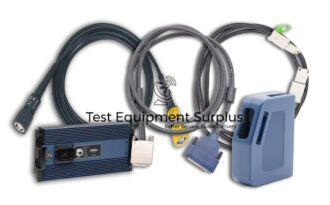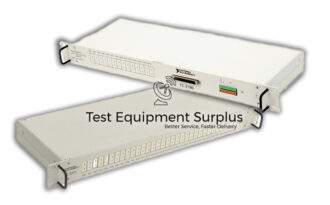Description
The National Instruments AT-MIO-16L Multifunction I/O Board, with part number 320476-01, is specifically designed for handling low-level signals, offering a variety of software-programmable gain settings such as 1, 10, 100, and 500 to accommodate different signal strengths.
Equipped with 16 analog inputs and a high-quality 12-bit analog to digital converter (ADC), this board ensures precise data acquisition, complemented by a digital to analog converter (DAC) for output capabilities. It also features eight digital I/O TTL lines and three 16-bit counter timers for extensive digital and timing operations.
Integration with external systems is seamless, thanks to the included Real-Time System Integration (RTSI) bus and the ability to interface with an SCXI system, allowing for the management of up to 3000 analog signals from various sources.
The AT-MIO-16L is fully compatible with PC systems and supports operating on Windows and DOS environments using NI-DAQ software. For software development, it supports LabVIEW for graphical programming and LabWindows/CVI for conventional programming, providing flexibility and power for a wide range of data acquisition and control applications.
| Specification | Detail |
|---|---|
| Product Name | National Instruments AT-MIO-16L Multifunction I/O Board |
| Part Number | 320476-01 |
| Signal Type | Low-Level Signals |
| Software-Programmable Gain Settings | 1, 10, 100, and 500 |
| Number of Analog Inputs | 16 |
| Analog to Digital Converter (ADC) | 12-bit |
| Digital to Analog Converter (DAC) | Yes |
| Digital I/O TTL Lines | 8 |
| Counter Timers | Three 16-bit |
| Real-Time System Integration (RTSI) Bus | Yes |
| SCXI System Interface Capability | Yes (up to 3000 analog signals) |
| Compatible with PC | Yes, using NI-DAQ software |
| Supported Operating Systems | Windows, DOS |
| Supported Software | LabVIEW, LabWindows/CVI, NI-DAQ |
| Programming Languages Support | Graphical programming (LabVIEW), Conventional programming (LabWindows) |
Question 1: What are the maximum gain settings available on the National Instruments AT-MIO-16L Multifunction I/O Board, and which operating systems does it support?
Answer 1: The National Instruments AT-MIO-16L Multifunction I/O Board offers software-programmable gain settings of 1, 10, 100, and 500 to accommodate different signal strengths.
Question 2: What types of programmable gain settings does the National Instruments AT-MIO-16L Multifunction I/O Board offer to handle different signal strengths?
Answer 2: The National Instruments AT-MIO-16L Multifunction I/O Board offers software-programmable gain settings of 1, 10, 100, and 500 to accommodate varying signal strengths.
Question 3: What gain settings are available on the National Instruments AT-MIO-16L Multifunction I/O Board to accommodate varying signal strengths?
Answer 3: The maximum gain settings available on the National Instruments AT-MIO-16L Multifunction I/O Board are 1, 10, 100, and 500, and it supports operating systems such as Windows and DOS.
Question 4: What are the characteristics and capabilities of the National Instruments AT-MIO-16L Multifunction I/O Board, and how does it provide flexibility for data acquisition and control applications in PC systems?
Answer 4: The National Instruments AT-MIO-16L Multifunction I/O Board offers software-programmable gain settings of 1, 10, 100, and 500 to handle low-level signals and it can indeed interface with an SCXI system to manage up to 3000 analog signals from various sources.
Question 5: What software-programmable gain settings are available on the National Instruments AT-MIO-16L Multifunction I/O Board to handle low-level signals, and can it interface with an SCXI system for managing multiple analog signals?
Answer 5: The National Instruments AT-MIO-16L Multifunction I/O Board is equipped with 16 analog inputs, a 12-bit ADC, a DAC, eight digital I/O TTL lines, and three 16-bit counter timers, featuring software-programmable gain settings for handling low-level signals and a Real-Time System Integration (RTSI) bus for interfacing with SCXI systems, thus providing flexibility for data acquisition and control applications in PC systems by supporting a wide range of signal strengths, ensuring




